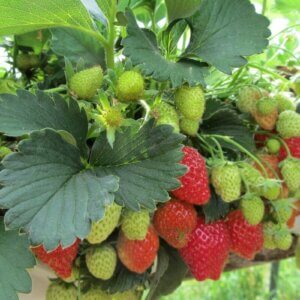No doubt, white mushrooms (also known as button mushrooms) are yummy. Those little white fungi that you can find at nearly every grocery store are adorable, affordable, and super versatile for cooking.
You can turn them into veggie tacos, stroganoff, scrambles, veggie burgers, and they are the perfect shape and size for stuffing. Button mushrooms have a really mild flavor and a pleasing texture that most palates can handle.

But we’re going to go beyond the basic button mushroom in this article and dive into the world of wilder mushrooms. You might find these unique beauties alongside button mushrooms at your local store, or you may need to go further afield and seek them at natural food stores or Asian food markets. If you’re very adventurous, you can always plan a mushroom hunting trip!
We’ve foraged a list of 20 not-so-common mushroom varieties that you can try out as a replacement for or addition to button mushrooms. Each type of mushroom is so unique that you can move through this whole list and never experience the same flavors or textures twice!
How to Store Fresh Mushrooms
Look for mushrooms that are dry to the touch (not slimy) and seem perky: no wilted stems or caps. Inspect the gills and stems for signs of mold. Gather a few mushrooms and give them a sniff to make sure they smell fresh, like the forest floor, and not at all funky or musty.
When purchased, use as soon as possible, or store for a few days. I have found the best storage is in a paper bag within a plastic bag: the paper ensures that the mushrooms don’t get slimy, while the plastic bag ensures they don’t get dehydrated.
However, even with this method, I’ve found that most mushrooms are only really good for about 2-3 days. After that, the caps and stems get wilted, and they lose their moisture. At this point, you could dehydrate them, or use in a dish where texture and moisture don’t matter as much, such as a pasta sauce.
Many mushrooms, including button, shiitakes, chanterelles, and creminis, can be frozen raw or cooked. Find a great tutorial here on The Spruce.
1. Morel Mushrooms
Morels are a highly sought-after wild mushroom, valued not only for their meaty and rich flavor but also their relative rarity. These are also popular as a foraged fungi because they are considered safer – very few other fungi look quite like the beautiful morel. They have a mild taste that is generally mushroomy.
Experts recommend choosing smaller morels that are fresh, firm, and dry. Like all mushrooms, it’s best to avoid any morels that are soggy or shriveled. Be sure to clean out the little holes in the caps that allow critters to take up residence, and remove any dirt that might be hiding. Daniel Gritzler has a very detailed tutorial on Serious Eats about choosing, cleaning, cutting, and basic preparation of morels. Another detail to note is that morels are best eaten cooked, since in raw form they have some compounds that might make you a bit sick.
Morel mushrooms have stand out nutritional benefits, including being high in natural Vitamin D, high in antioxidants, and boasting liver- and immunoprotective compounds.
2. Cremini Mushrooms
Cremini mushrooms are actually baby portobello mushrooms, but they are different enough in flavor and texture to warrant their own section. Creminis, similar in size, shape, and flavor to button mushrooms, are differentiated by their light or dark brown tops, but creamy white undersides and stems. I find that creminis are an excellent substitute for button mushrooms, and they add just a bit more color to a dish, like in these California Veggie Tacos.
Creminis have a solid texture when fresh, so they hold texture well when thinly sliced raw for salads, or chopped and cooked for stir-fry dishes or soups.
And regarding the health benefits, turns out these commonplace mushrooms often beat their more exotic counterparts in benefits: cremini mushrooms are high in conjugated linolenic acid that can help reduce breast cancer risk. Preliminary studies have also shown that creminis are high in elusive B12, as well as adding anti-inflammatory and immune-boosting benefits to our diet.
3. Oyster Mushrooms
Oyster mushrooms are considered one of the tastiest mushroom varieties, with a chewy but delicate texture and a sweet, nutty flavor. They are also known for their licorice or anise scent. Note that these are different from King Oyster Mushrooms.
Oyster mushrooms offer some unique health benefits too, notably their natural statin compounds, which are great for managing cholesterol. It’s also linked with anti-cancerous tumor effects.
4. Shiitake Mushrooms
Shiitake mushrooms are very common in Japanese foods, and they can be used both fresh or dried. And unlike so many foods, shiitakes actually have a stronger flavor when dried (and then rehydrated).
Fresh shiitakes have a pleasantly slick texture, but a firm bite, making them a bit of a ‘meaty’ mushroom. Personally, I think their flavor is quite overpowering: to me, it leaves a dank aftertaste, but these mushrooms are prized for that very flavor, so you can ignore me. This rich flavor means they are quite good as additions to veggie broth or stock, which is a great use of the woody stems.
Shiitakes offer more than flavor though: they are high in biotin and copper (one of the most potent sources of copper, actually), and help reduce inflammation. Shiitakes are also high in compounds called beta-glucans, which are excellent for digestive health.
5. Enoki Mushrooms
As a fungus-lover, I think all mushrooms are cute, but enoki mushrooms might be the cutest. The name is cute, and their noodle-like shape and teeny caps make them really lovable. Their super mild flavor and crunchy yet slimy texture make them very interesting.
Enoki mushrooms are often used in soups (like pho or ramen), but they can also be used in stir-fry dishes, in sushi, and in noodle dishes, where their shape and texture make it sometimes difficult to know whether you’re eating a noodle or a mushroom!
Enoki mushrooms are often sold with their ‘base’ attached, so you can just break off the mushrooms from the base and enjoy raw or lightly cooked.
6. Chanterelle Mushrooms
Chanterelles have become more common in recent years, and are certainly one of the most interesting mushrooms. Chanterelles are often yellow to deep orange but can also be pink. Their flavor, according to WildEdible, is mildly peppery with a distinct fruity apricot-like aroma. They have limited seasonality, so grab them as soon as you see them in markets or stores. These can be used in pastas, veggie stir-fries, and as a meat replacement in many dishes, like tacos.
These mushrooms don’t dehydrate well, but they do freeze well, and they can even be pickled!
These pretty mushrooms are really good for us too: they are great sources of protein, Vitamin D and many of the B vitamins. Chanterelles also include a bunch of minerals like potassium, copper, and selenium.
7. Portobello Mushrooms
One of the more common types of mushrooms on this list, portobellos are perhaps most famous for their ability to stand in for a burger for those who prefer vegan or vegetarian foods. Portobellos are large mushrooms (grown-up cremini mushrooms, actually) that have a very firm texture, which allows them to absorb marinades and sauces well.
My favorite way to prepare portobellos is to remove the stem, then cover with a marinade like this one that features balsamic vinegar, olive oil, some mirin, and herbs. Let the mushrooms marinate a few hours (or overnight) then roast in the oven until wilted and browned. Serve on a bun, or sliced for sandwiches or tacos. I’ve also used these large mushrooms as a stuffed mushroom, which is a spectacular dish to serve to dinner guests.
When I can get super fresh portobellos from my farmer friend, they are actually a bit pink on the gills, something I had never seen before. He explained that it’s natural if they are very fresh! But unless you know a mushroom farmer, you’re likely buying mushrooms at the store, so be sure to choose portobellos that are firm and dry to the touch.
The caps should be soft and rounded; if the edges of the cap are a bit wilted, that means they are a little bit older, but likely still good. Store the portabellos using the paper bag/plastic bag option listed above, and use within a few days. Sometimes you’ll find these mushrooms packed in styrofoam containers with plastic, but the mushrooms will likely get funky if left in this packaging since moisture can’t escape.
8. Porcini Mushrooms
Porcini mushrooms are usually found in Italian foods, notably risotto. Porcini mushrooms can be foraged fresh, or dried to be used in various Italian-themed recipes. I remember fondly a pizza I had in Verona, Italy, that was loaded with fresh porcini mushrooms, fresh basil, cheese and that’s it – a lovely culinary memory that encapsulates Italy for me! They have a silky but firm texture that is pleasantly weird. I think that this would be a ‘mushroom lovers’ mushroom since the texture might turn some folks off.
Porcinis are pretty dang healthy too: they contain niacin, potassium, selenium, and protein.
9. Black Trumpet Mushrooms
These dark, delicate mushrooms are highly sought after at high-end restaurants and with home chefs. New York Times says these mushrooms add deep flavor and meaty texture and have “a taste unlike any other mushroom, earthy and almost smoky.” This strong flavor means they need little in the way of additions: serve with pasta, on pizza, or in a sauce.
Black trumpets range in harvest location from Eastern Europe to Northern California. Not only are these little mushrooms insanely delicious, they’re super easy to clean and prepare. Simple dunk in water then squeeze out; they often do not even need to be chopped.
10. Puffball Mushrooms
Puffballs are some of the wildest looking mushrooms on the list, and they don’t look like other mushrooms. They don’t have caps or gills, instead, they keep their spores on the inside. These often huge white fungus monsters can be a yummy addition to your kitchen. ForagerChef has an excellent review of puffballs, including how to spot them (in the forest or in fields), how to forage for them, prep them (chop away any holes with bugs), and how to cook them (on a grill, sautéed, turned in gravy, or used in ravioli).
11. Maitake Mushrooms (Hen of the Woods Mushrooms)
Maitake (‘dancing mushrooms’ in Japanese) are widely available and many-named: these are often known as Hen of the Woods mushrooms, but are sometimes called ram’s head or sheep’s head. These mushrooms are frilly, delicate, and beautiful. These often grow in large clusters at the base of oak trees and can be found as small as a handful or as large as 50 pounds. Like many mushrooms, their unique flavor is best with simple preparations, like sautéed in butter or served with pasta, but this Mushroom & Thyme Cheesecake looks incredible, too.
Maitake also offers well-known healing benefits, including immune support, anti-cancer properties, blood pressure and blood sugar balancing They can also help with conditions like chronic fatigue syndrome (CFS) and infertility caused by polycystic ovary syndrome.
12. Straw Mushrooms (Paddy Straw Mushrooms)
These very simple mushrooms have a very beautiful name: Volvariella volvacea. These little mushrooms, which you’re most likely to find in Chinese, Thai, or Vietnamese foods, grow on rice straw. Unless you’re buying them fresh at an Asian market, the ones you are eating are canned.
While I find their slightly slick, slimy texture unappealing, they are very common and well-loved in lots of different recipes. And a good reason to work with them is their health benefits: Healthiest Foods says these mushrooms are a good source of fiber, protein, copper, potassium, zinc, selenium and B vitamins.
13. Coral Mushrooms
Coral mushrooms get their name from their sea-based lookalikes. They are another mushroom that is likely found in the wild in the Eastern United States (seemingly not on the West Coast). There are many varieties of coral mushrooms that should NOT be eaten. ForagerChef has a quick guide, but as always with mushroom foraging, be sure to consult an expert before eating anything you’re not 100% sure about. Mushroom Experts says this fungus should smell of “faintly of newly dug potatoes” and has a taste that is mild or peppery-acrid.
14. Matsutake Mushrooms (Pine mushrooms)
Matsutake mushrooms are highly prized for their uniquely spicy and fragrant nature. While they grow in a range of regions, ranging from US/Canada to Sweden to China. But they are hard to find and offer only one harvest each year, and a persistent nematode is endangering the pine forests in Japan where the mushroom thrives. All of these conditions mean that matsutake mushrooms are often quite expensive. Mycological Society of San Francisco has great suggestions for making the most of this mushroom by using it with grains, in sauce, and more.
15. Honey Mushrooms (Honey Fungus)
Honest Food has a great account of how to identify mushrooms, which he did with precision to find these special honey mushrooms. While these are not very popular in North America, they apparently have quite a history in Eastern Europe. He writes, “Apparently honey mushrooms are not well thought of in the mushroom world. Mediocre was the universal report. Slimy, remarked another. Then I read that the Russians, Poles and Ukrainians loved these things, and that there is a traditional pierogi made in Ukraine with honey mushrooms.” To dig deeper, read MSSF’s account of the flavors (mildly-sweet) and texture (gelatinous) of these wild mushrooms.
16. Beech Mushrooms (Shimeji or Bunshimeji Mushrooms)
The Japanese market near my house carries these mushrooms, and I love experimenting with them. Like maitake mushrooms, they grow in clumps, and the tiny mushrooms often fall off in your hands, making preparation really simple. There are a few varieties of beech mushrooms to use (white beech mushrooms are known as bunapi shimeji and brown beech mushrooms known as buna shimeji), but I find their flavor to be the same – which is actually quite bland. But what they lack in flavor they make up for in cuteness and texture, which is firm and pleasant. Hokto-Kinoko has a great explanation of the health benefits (Vitamin D! B12! Niacin! Fiber!) and how to prepare and cook these little mushrooms
17. King Trumpet Mushrooms (Eryngii Mushrooms)
These are very different than Trumpet mushrooms (#9 on our list) in both flavor and texture. I find the texture of King Trumpets to be very firm, almost ‘squeaky’ against your teeth. They are so firm that they are ideally cooked in small pieces so as not to overwhelm the mouth. In fact, they are so toothsome that they can be used to replace/replicate meat in many dishes. These are often found packaged in Asian markets and can be cooked in many different ways. These are another super healthy mushroom to add to your diet and can be used in a range of recipes.
18. Lobster Mushrooms
Named for their wild color and flavor that resembles their Crustacean namesake. Lobsters can be found in the wild, usually in old-growth forests in North America from July to October. The size of the lobster mushroom varies, depending on the size of the host mushroom.
On average they are about 15 – 20cm (6 – 8”) tall. They grow differently than other mushrooms, and are actually, “an example of a mold attacking a mushroom. Hypomyces lactifluorum attacks and parasitizes Lactarius piperatus or Russula brevipes and covers the entire fruit body with an orange skin.” A truly WILD mushroom!
19. Chicken of the Woods Mushrooms
This wild mushroom is considered one of the ‘fool-proof four‘, a group of wild edible mushrooms that is easily identifiable and generally safe to eat. These are not to be confused with Hen of the Woods or Maitake mushrooms (#11 on our list). This mushroom can be found in the Summer or Fall, and can range in both color (bright orange, bright yellow, and down to white when they are older) and size (a good tree can yield a bunch up to 50 pounds). The young Chicken of the Woods is “succulent” and has a mild flavor (some saying it does, in fact, taste like chicken), but it can turn sour when older. Since these mushrooms can be quite large, you can find how to prepare and use all parts of it here on Mushroom Appreciation.
20. Wood Ear Mushrooms (Cloud Ear Mushrooms)
Wood Ear mushrooms are what’s considered a jelly fungus, and if you’ve even eaten hot and sour soup you’re probably had these slightly slick fungi, which resembles wakame visually and texturally. Wood ear mushroms don’t have much flavor, but are nice carriers of flavor for soups, sauces, or curries. These mushrooms are dark or medium brown in color (and black with age), and have a unique shape that is “gill-less [and] are somewhat cup-shaped, with a thick, smooth, wavy cap and almost no stem. The color of the skin often takes on the color of the tree that it grows on.” These are often found dried, and can be reconstituted in hot water before using.










































One of the very brief post i have read about mushrooms till now but i would recommend you to check this one as well if you are trying to freeze mushrooms for longterm http://www.healthyrecipesfor.com/can-you-freeze-mushrooms/